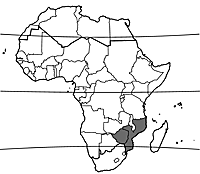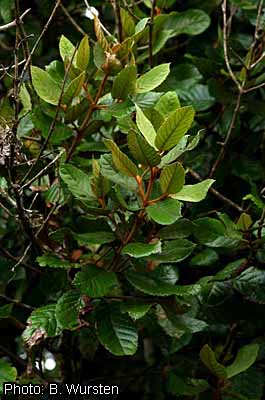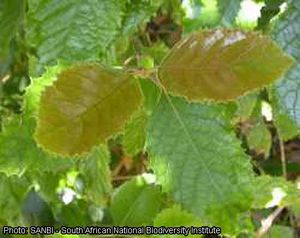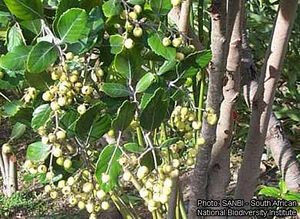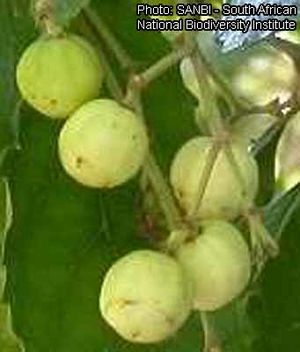Curtisia dentata (PROTA)
Introduction |
| General importance | |
| Geographic coverage Africa | |
| Geographic coverage World | |
| Dye / tannin | |
| Essential oil / exudate | |
| Medicinal | |
| Timber | |
| Ornamental | |
Curtisia dentata (Burm.f.) C.A.Sm.
- Protologue: Journ. S. Afr. For. Ass. 20: 50 (1951).
- Family: Cornaceae (APG: Curtisiaceae)
- Chromosome number: n = 13
Synonyms
- Curtisia faginea Aiton (1789).
Vernacular names
- Assegai tree (En).
Origin and geographic distribution
Curtisia dentata occurs in eastern Zimbabwe, southern Mozambique, eastern and southern South Africa, and Swaziland.
Uses
The wood has been used for furniture, heavy flooring, wagons, spokes and tool handles. It is suitable for interior trim, ship building, sporting goods, toys, novelties, agricultural implements, musical instruments, carving, pattern making and turnery.
Bark extracts are used in traditional medicine, especially by Zulu people, to treat diarrhoea and stomach complaints, to purify the blood, and as aphrodisiac. The bark is also used to treat pimples and in skin lighteners. It has been used for tanning leather. Curtisia dentata is planted as ornamental in gardens and in hedges.
Production and international trade
In 1998 the annual trade of Curtisia dentata bark in KwaZulu-Natal Province (South Africa) was estimated at 23.9 t.
Properties
The heartwood is greyish brown to purplish red and not distinctly demarcated from the slightly paler, fairly wide sapwood. The grain is straight, texture fine and even. The wood is heavy, with a density of 870–930 kg/m³ at 12% moisture content. It is difficult to dry, often developing deep cracks on the surface. Very mild schedules are needed in kiln drying. The rates of shrinkage are rather high. Once dry, the wood is stable in service.
At 12% moisture content, the modulus of rupture is 116–131 N/mm², modulus of elasticity 16,660–18,720 N/mm², compression parallel to grain 72 N/mm², shear 13.5–15 N/mm², Janka side hardness 11, 290–11,550 N and Janka end hardness 12,620–13,110 N. Although the wood is heavy, hard and tough, it saws and works fairly well. It can be planed well and produces a smooth and glossy surface. Pre-boring is necessary in nailing and screwing. The wood glues and turns well. It is fairly durable, also when used in contact with water and soil.
The bark contains up to 21% of tannin, which is probably responsible for the medicinal properties against diarrhoea. Lupeol, betulinic acid, ursolic acid and 2α-hydroxyursolic acid have been isolated from the leaves; the three latter compounds showed pronounced antifungal activity, especially against Candida albicans. Leaf extracts also showed considerable antibacterial activity against a wide panel of bacteria.
Description
- Evergreen shrub or small to medium-sized tree up to 20 m tall; bole usually cylindrical, up to 180 cm in diameter, without buttresses; bark surface smooth and brown in young trees, becoming fissured and dark brown in older trees; twigs densely reddish brown hairy when young, later becoming more or less glabrous.
- Leaves opposite, simple; stipules absent; petiole up to 2.5 cm long; blade ovate to elliptical or nearly circular, 2.5–10 cm × 2.5–5.5(–7.5) cm, cuneate to rounded at base, acute to rounded at apex, margins distinctly toothed especially in upper part of leaf, densely reddish brown hairy below when young, but becoming glabrous, pinnately veined with 6–10 pairs of prominent lateral veins.
- Inflorescence a terminal panicle up to 12 cm long, densely hairy, many-flowered.
- Flowers bisexual, regular, 4-merous, sessile; calyx fused with the ovary, with broadly triangular teeth, hairy; petals free, ovate, 1–1.5 mm long, hairy outside; stamens free, alternating with the petals, c. 1 mm long; ovary inferior, top-shaped, hairy, 4-celled, style short, stigma 4-lobed.
- Fruit an ovoid to globose drupe 5–10 mm in diameter, white becoming red when fully mature, crowned with the remains of calyx and style, 4-seeded
Other botanical information
Trees grow comparatively slow under natural conditions, but may be fast-growing in cultivation. They flower from October to March. Curtisia dentata is almost entirely self-pollinating. Fruits ripen 6–10 months after flowering, but they often develop sporadically. They remain on the tree for a long time and are eaten by birds, monkeys and wild pigs, which may act as seed dispersers; the lourie and the bush dove have been recorded as the main seed dispersers.
Curtisia comprises a single species. It has long been included in Cornaceae, but recently it has been classified in its own family Curtisiaceae, mainly because of differences in anatomy of the ovary. Phylogeny reconstruction based on molecular data grouped Curtisia close to Grubbia, a genus of 3 shrub species endemic to southern South Africa, and it has been suggested to place both genera in Grubbiaceae, also because of morphological similarities; however, the fruits are completely different.
Ecology
Curtisia dentata occurs in evergreen forest, grassland on mountain slopes and coastal scrub forest, from sea-level up to 1800 m altitude. Trees develop best in medium-moist forest. Curtisia dentata seems to be a later successional species in the forest in southern South Africa, where it is often associated with Olea capensis L., Podocarpus latifolius (Thunb.) R.Br. ex Mirb., Afrocarpus falcatus (Thunb.) C.N.Page and Ocotea bullata (Burch.) Baill.
Management
The germination rate of fresh seed is about 50%. Under natural conditions seeds take 6–12 months to germinate after the fruits have fallen. When the fleshy fruit pulp is removed, germination may start after 3–4 weeks. For good growth, seedlings should be planted in deep, fertile soil with plenty of compost, lightly covered with soil, and under light shade. They are susceptible to drought; regular watering is needed until the young trees are about 3 years old. Once established, the tree can withstand moderate drought. Seedlings and saplings are sensitive to frost.
Curtisia dentata occurs scattered in the forest and is never dominant or even co-dominant. Trees respond to harvesting by producing vigorous coppice shoots, both from wounds in the bark as well as from stumps. Root suckers may also develop. The centre of boles is often defective with purplish brown heart rot due to incipient decay. Therefore, logs are often quarter-sawn before drying and the central portion of the bole is often discarded. Trees are often heavily parasitized by fungi and insects. The seedlings are liable to attack by damping-off fungi.
Genetic resources
Curtisia dentata occurs only very locally in tropical Africa. In South Africa it has a wider distribution, but taller specimens have become rare because of exploitation for its timber in the past. The popularity of the bark as medicine also contributes considerably to the existing pressure on populations of Curtisia dentata. In KwaZulu-Natal Province in South Africa, the species has already been considered as vulnerable and declining in 1988 because of over-exploitation of the bark.
Prospects
Curtisia dentata is too uncommon in tropical Africa to have prospects as a commercial timber tree. This seems also the case in South Africa, where it is more widespread and common, because large trees have become rare because of over-exploitation and because of the rather slow growth under natural conditions. It seems to have much better prospects as ornamental shrub or tree. It deserves more research attention concerning its pharmacological properties. Recent investigations demonstrated pronounced antibacterial and antifungal properties, supporting the use of Curtisia dentata in traditional medicine.
Major references
- Bolza, E. & Keating, W.G., 1972. African timbers: the properties, uses and characteristics of 700 species. Division of Building Research, CSIRO, Melbourne, Australia. 710 pp.
- Cannon, J.F.M., 1978. Cornaceae. In: Launert, E. (Editor). Flora Zambesiaca. Volume 4. Flora Zambesiaca Managing Committee, London, United Kingdom. pp. 635–638.
- Coates Palgrave, K., 1983. Trees of southern Africa. 2nd Edition. Struik Publishers, Cape Town, South Africa. 959 pp.
- Notten, A., 2004. Curtisia dentata. [Internet] South African National Biodiversity Institute, Kirstenbosch, South Africa. http://www.plantzafrica.com/ plantcd/ curtisdent.htm July 2009.
- Takahashi, A., 1978. Compilation of data on the mechanical properties of foreign woods (part 3) Africa. Shimane University, Matsue, Japan, 248 pp.
Other references
- Cunningham, A.B., 1990. People and medicines: the exploitation and conservation of traditional Zulu medicinal plants. In: Ihlenfeldt, H.-D. (Editor). Proceedings of the twelfth plenary meeting of AETFAT, 4–10 September 1988, Hamburg, Germany. Mitteilungen aus dem Institut für Allgemeine Botanik Hamburg 23b: 979–990.
- Fan, C. & Xiang, Q.-Y., 2003. Phylogenetic analyses of Cornales base don 26S rRNA and combined 26S r DNA- MATK-RBCL sequence data. American Journal of Botany 90: 1357–1372.
- Grace, O.M., Prendergast, H.D.V., Jäger, A.K. & van Staden, J., 2002. Bark medicines in traditional healthcare in KwaZulu-Natal, South Africa: an inventory. South African Journal of Botany 69(3): 301–363.
- Grace, O.M., Prendergast, H.D.V., van Staden, J. & Jäger, A.K., 2002. The status of bark in South African traditional health care. South African Journal of Botany 68: 21–30.
- Grierson, D.S. & Afolayan, A.J., 1999. An ethnobotanical study of plants used for the treatment of wounds in the Eastern Cape, South Africa. Journal of Ethnopharmacology 67: 327–332.
- Kubitzki, K., 2004. Curtisiaceae. In: Kubitzki, K. (Editor). The families and genera of vascular plants. Volume 6. Flowering plants - dicotyledons, Celastrales, Oxidales, Rosales, Cornales, Ericales. Springer-Verlag, Berlin, Heidelberg, Germany. pp. 112–113.
- Palmer, E. & Pitman, N., 1972–1974. Trees of southern Africa, covering all known indigenous species in the Republic of South Africa, South-West Africa, Botswana, Lesotho and Swaziland. 3 volumes. Balkema, Cape Town, South Africa. 2235 pp.
- Shai, L.J., McGaw, L.J., Aderogba, M.A., Mdee, L.K. & Eloff, J.N., 2008. Four pentacyclic triterpenoids with antifungal and antibacterial activity from Curtisia dentata (Burm.f.) C.A.Sm. leaves. Journal of Ethnopharmacology 119(2): 238–244.
- Shai, L.J., McGaw, L.J., Masoko, P. & Eloff, J.N., 2008. Antifungal and antibacterial activity of seven traditionally used South African plants active against Candida albicans. South African Journal of Botany 74(4): 677–684.
- van Wyk, B.E., van Oudtshoorn, B. & Gericke, N., 1997. Medicinal plants of South Africa. Briza Publications, Pretoria, South Africa. 304 pp.
Author(s)
- R.H.M.J. Lemmens, PROTA Network Office Europe, Wageningen University, P.O. Box 341, 6700 AH Wageningen, Netherlands
Correct citation of this article
Lemmens, R.H.M.J., 2010. Curtisia dentata (Burm.f.) C.A.Sm. [Internet] Record from PROTA4U. Lemmens, R.H.M.J., Louppe, D. & Oteng-Amoako, A.A. (Editors). PROTA (Plant Resources of Tropical Africa / Ressources végétales de l’Afrique tropicale), Wageningen, Netherlands.
Accessed 18 December 2024.
- See the Prota4U database.

